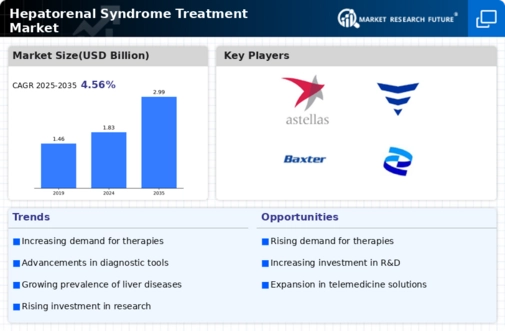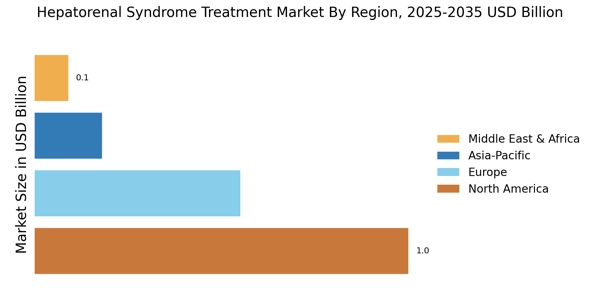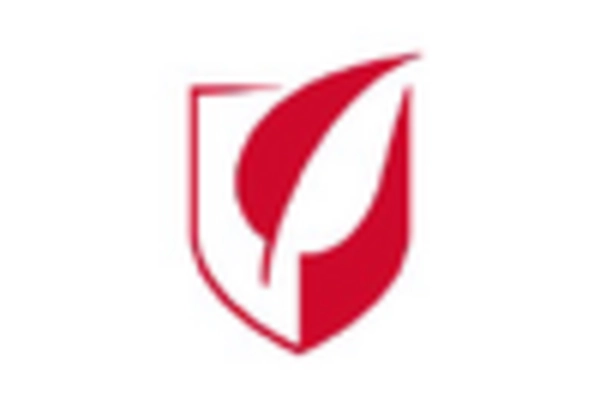Rising Incidence of Liver Diseases
The increasing prevalence of liver diseases, particularly cirrhosis, is a primary driver for the Hepatorenal Syndrome Treatment Market. As liver dysfunction progresses, the risk of developing hepatorenal syndrome escalates, leading to a greater demand for effective treatment options. According to recent data, liver diseases affect millions worldwide, with cirrhosis being a leading cause of morbidity and mortality. This trend suggests that healthcare systems must adapt to manage the growing patient population, thereby propelling the market for hepatorenal syndrome treatments. The rising incidence of liver-related complications necessitates innovative therapeutic solutions, which could potentially enhance patient outcomes and reduce healthcare costs associated with advanced liver disease. Consequently, pharmaceutical companies are likely to invest in research and development to address this urgent need, further stimulating the Hepatorenal Syndrome Treatment Market.
Advancements in Diagnostic Technologies
Technological advancements in diagnostic tools are significantly influencing the Hepatorenal Syndrome Treatment Market. Enhanced imaging techniques and biomarkers have improved the accuracy of diagnosing hepatorenal syndrome, allowing for earlier intervention and treatment. The ability to identify patients at risk of developing this condition has become increasingly important, as timely management can lead to better prognoses. Recent studies indicate that early diagnosis can reduce the progression of liver disease and associated renal complications, thereby increasing the demand for targeted therapies. As healthcare providers adopt these advanced diagnostic methods, the market for hepatorenal syndrome treatments is expected to expand. This trend underscores the importance of integrating innovative diagnostic solutions into clinical practice, which may ultimately lead to improved patient outcomes and a more robust Hepatorenal Syndrome Treatment Market.
Growing Awareness and Education Initiatives
The rise in awareness and education initiatives surrounding liver health and hepatorenal syndrome is a crucial driver for the Hepatorenal Syndrome Treatment Market. Increased public and professional knowledge about the risks and symptoms associated with liver disease has led to more patients seeking medical attention sooner. Campaigns aimed at educating healthcare providers and the general public about the importance of early detection and treatment options are gaining traction. This heightened awareness is likely to result in an uptick in diagnosed cases of hepatorenal syndrome, thereby increasing the demand for effective treatment modalities. Furthermore, as more patients become informed about their health conditions, they may actively seek out advanced therapeutic options, contributing to the growth of the Hepatorenal Syndrome Treatment Market. The ongoing emphasis on education is expected to play a pivotal role in shaping future market dynamics.
Regulatory Support for Innovative Therapies
Regulatory bodies are increasingly providing support for the development and approval of innovative therapies within the Hepatorenal Syndrome Treatment Market. This trend is characterized by streamlined approval processes and incentives for companies that focus on addressing rare and complex conditions like hepatorenal syndrome. Regulatory agencies are recognizing the urgent need for effective treatments, which has led to the establishment of programs aimed at expediting the development of new drugs. This supportive environment encourages pharmaceutical companies to invest in research and bring novel therapies to market more quickly. As a result, the availability of innovative treatment options is expected to increase, potentially improving patient outcomes and expanding the Hepatorenal Syndrome Treatment Market. The collaboration between regulatory authorities and industry stakeholders is likely to play a crucial role in shaping the future landscape of this market.
Increased Investment in Research and Development
The Hepatorenal Syndrome Treatment Market is experiencing a surge in investment directed towards research and development. Pharmaceutical companies are increasingly recognizing the unmet medical needs associated with hepatorenal syndrome and are allocating resources to develop novel therapeutic agents. This trend is driven by the potential for high returns on investment, given the growing patient population and the complexity of the condition. Recent data suggests that the market for liver disease treatments is projected to grow significantly, prompting companies to innovate and expand their product portfolios. The focus on R&D not only aims to improve existing treatment options but also seeks to introduce groundbreaking therapies that could transform patient care. As a result, the influx of capital into research initiatives is likely to enhance the Hepatorenal Syndrome Treatment Market, fostering a competitive landscape that prioritizes patient outcomes.


















Leave a Comment